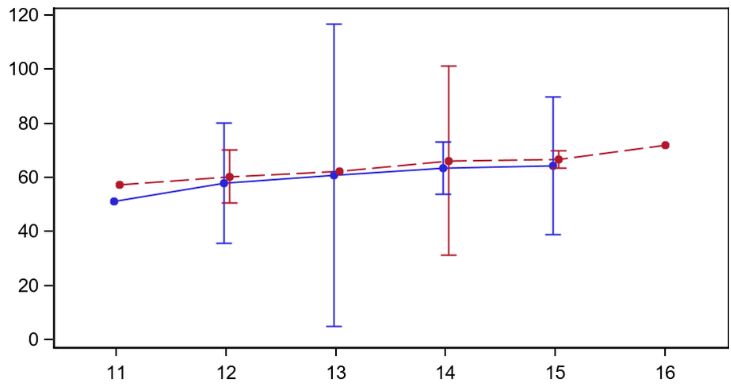Posts for: jlg1000
Feb 7, 2024 15:59:43 #
selmslie wrote:
This graph is the result of a test I did on the Z7... (show quote)
The issue is not WHAT you measured, but HOW you measured it and how you treated the measurement uncertainties.
Something like this graph.
The way to calculate the error bars is to perform many times *the very same measurement* at different conditions (temperature, time of day, etc.)
Then the error marks are calculated by the Standard Deviation method.
For example, if the bars are +/- 1 SD (what means 2 SD total) then you are 99.5% certain that another measurement of the same data point will fall inside the uncertainty bar.
Ya know... for people without math training, a measurement is just that, a fixed value. But once you go down the (math) rabbit hole, you'll discover that - for example - if you measure 100 times the voltage of same battery with, you'll get 100 different values. That is the nature of reality.
Just make this mental experiment: measure the length of a table. If your use a simple ruler, you'll get always the same reading. **BUT** if you use a measuring slide with a resolution is 1/20 of an inch, each time you measure the table you'll get a different rading.

Feb 7, 2024 14:54:27 #
Rongnongno wrote:
"How about the same face?
It is intentionally the same... they want to make a political point that both parties (UCR and KK) are the same thing.
"Now, this should be posted in a different section like chit-chat.
It is intentionally the same... they want to make a political point that both parties (UCR and KK) are the same thing.
"Now, this should be posted in a different section like chit-chat.
Maybe... but my point was not to talk about (spicy) argentine politics, but about the impact AI is already having on commercial photography, and - in general - graphic arts.
In the distant past (a couple of months ago) to create something like this would have taken a photograph to grab the people, and then a Photoshop operator to create the whole composition. Not any longer.
Feb 7, 2024 14:04:20 #
It was only matter of time that AI generated images would make their debut in mainstream media...
This one appeared in a political article in the most important newspaper in Argentina today.
Source: https://www.clarin.com/politica/javier-milei-compartio-provocativo-meme-radicales-redes-luego-cayera-ley-omnibus_0_e7cKkSebhE.html
It has all telltale signs of a crude AI generated image (like the extra finger in the guy with the blue t-shirt) and it is far inferior to the ones I'm able to create, but the trend is clear. No more commercial graphic artists, photoshopers, etc. This one was made in a couple of minutes, not hours.
Still the letters on the t-shirts are correct and also the image of the argentine congress building in the background is correct.
This one appeared in a political article in the most important newspaper in Argentina today.
Source: https://www.clarin.com/politica/javier-milei-compartio-provocativo-meme-radicales-redes-luego-cayera-ley-omnibus_0_e7cKkSebhE.html
It has all telltale signs of a crude AI generated image (like the extra finger in the guy with the blue t-shirt) and it is far inferior to the ones I'm able to create, but the trend is clear. No more commercial graphic artists, photoshopers, etc. This one was made in a couple of minutes, not hours.
Still the letters on the t-shirts are correct and also the image of the argentine congress building in the background is correct.

Feb 7, 2024 12:37:40 #
selmslie wrote:
Absolutely incorrect! br br Film camera meters ma... (show quote)
Amazing.
First:
"Calibrating an instrument means a statistical procedure in which it is compared to an instrument of higher accuracy and which is traceable to a standard."
This holds, because it is the *very definition of calibration" It is true for light meters, volt meters, even tuning forks and rulers.
Second:
"The camera is not such thing, it has many more sources of inaccuracy like shutter speed, iso and aperture, plus in camera processing."
Still holds. While it is true that modern cameras are more accurate than film, still can not be used as a standard to compare any instrument (light meter, or whatever) because:
a) you don't know if your camera had any calibration issues after it was released from the factory
b) it lacks a laboratoy certificate of calibration
Believe me, I design electronic instruments and had to study this trough and in fact, in a occasion - because I lacked a proper meter (assistant forgot it) - I tried to make a make a luminance metering of a road with my A7C and it had such a dispersion that it was not statistically meaningful.
The next night, I could perform the measurement with a proper meter with a valid certificate.
Besides, a illuminance or luminance meter should be calibrated once a year (typically after DIN 5032 Part 7) , after that the certificate is no longer valid.
Besides 2, we are talking engineering here. Any statement without a number is meaningless... your curves lack the one and two standard deviation markers, se we really don't know what they mean. "
DMWAE rule.

Feb 7, 2024 06:16:12 #
jamesl wrote:
---- br Put an 18% gray card in the same light as ... (show quote)
Calibrating an instrument means a statistical procedure in which it is compared to an instrument of higher accuracy and which is traceable to a standard.
The camera is not such thing, it has many more sources of inaccuracy like shutter speed, iso and aperture, plus in camera processing.
Therefore, as some pointed out, if it is a light meter - aka luxmeter - then NIST is the solution (for a fee, of course)
Feb 6, 2024 20:45:21 #
hobie 33 wrote:
This image seems appropriate for today's weather, cold, cloudy and windy.
Awesome !!
I'd rather wouldn't go outside...
Down here, when the sky looks like this, probably a turbonada is coming. (A kind of horizontal tornado... kills people, destroys stuff)
Feb 6, 2024 06:31:42 #
Mark Sturtevant wrote:
I think it means you are not red-green color blind.
Hmmm... Interesting.
Color blind people lack the photoreceptors for one of the three colors (RGB)
For the illusion to work you don't need the green receptor to see the green dot, everything happens in postprocess (brain + optical nerve)
I'd be interested to hear what a true color blind person actually sees. Anyone on the group?
Feb 4, 2024 09:49:10 #
Longshadow wrote:
I would have adjusted the original crop to not cut the cow.
Why? The cow can be pasted again into the composition.
Feb 2, 2024 19:31:15 #
Longshadow wrote:
Curious - How does a clear glass filter negate the lens coatings?
Because it causes reflections, unless it is also very good coated... in which case it might cost well north of $100
Feb 2, 2024 18:09:43 #
Feb 2, 2024 17:22:35 #
Longshadow wrote:
I don't have to dig out the cable and make sure the camera has a sufficient charge in the battery for the duration of the process.
Less than 10 seconds to remove the card and insert it into the reader.
I use a card reader all the time.
Less than 10 seconds to remove the card and insert it into the reader.
I use a card reader all the time.
1) Sony's do charge when connected to USB
2) I've got a cable harness connected to my rig
3) USB was designed to connect and disconnect
4) I've wrote a program that detects the camera, downloads all photos to predefined directories, backups they y to NAS, checks file integrity, and then deletes them from the camera.
Si, I usually keep my camera connected behind my monitors, and grab it when needed.
Feb 2, 2024 17:14:40 #
Longshadow wrote:
Do you use a protective filter on your lens(es)?
Lets see how many people loose their marbles on this one.....

Link in next post.....
Lets see how many people loose their marbles on this one.....


Link in next post.....
0
Jan 28, 2024 14:11:51 #
jerryc41 wrote:
I consider myself lucky to be looking forward to my 80th birthday in a few months. So many people never make to half that age. Take a look at the world average and averages by country.
https://www.worldometers.info/demographics/life-expectancy/
Unfortunately, I suspect that some people will not be able to control themselves, and this will be sent to The Attic.
https://www.worldometers.info/demographics/life-expectancy/
Unfortunately, I suspect that some people will not be able to control themselves, and this will be sent to The Attic.

RAW shooters tends to outlive JPEG shooters

Jan 28, 2024 14:05:45 #
SteveFranz wrote:
I don't know if it is still true, but I seem to recall that regular coffee was typically made with Arabica coffee beans and De-Caf used more Robusta.
No, the process is the same for both beans.
Besides, Robusta tends to have more caffeine than Arabica
Jan 28, 2024 14:02:57 #
Longshadow wrote:
I'd like to know how they get the caffeine out without ruining the coffee......
Watch this https://youtu.be/Z2fNQOYHWYA?si=kE2Jghv8RTc8LF9r,
I'm a coffee freak... got expresso machine, adjustable electric grinder, every imaginable coffee gadget, buy fresh beans, etc.
I'd NEVER brew nor drink decaf, I believe decaffeinating coffee is a blasphemy and should be punished by burning at the stake.
